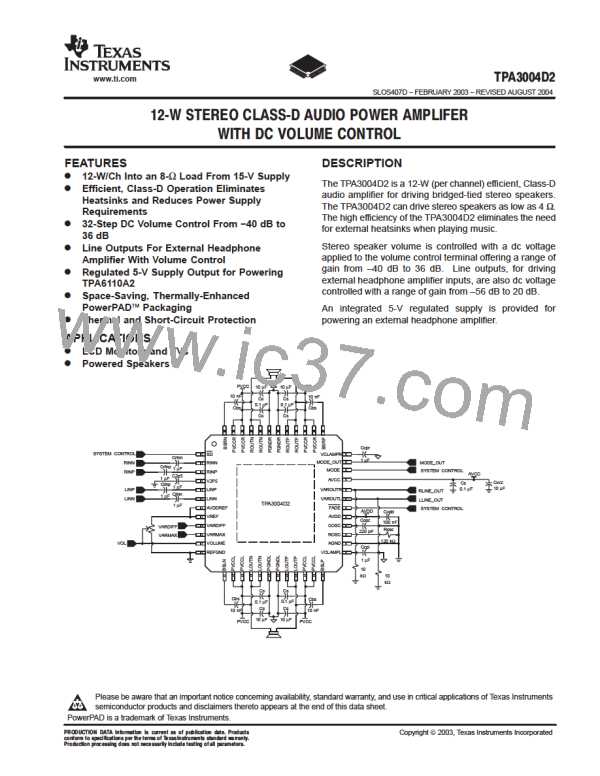www.ti.com
ꢀ ꢁꢂ ꢃꢄꢄ ꢅꢆ ꢇ
SLOS407D − FEBRUARY 2003 − REVISED AUGUST 2004
Decreasing Voltage on
VOLUME Terminal
5.6
3.1
0.5
Increasing Voltage on
VOLUME Terminal
2.00
2.21
(40.1%*VREF)
2.10 2.11
(44.1%*VREF)
(41.9%*VREF)
(42.3%*VREF)
Voltage on VOLUME Pin − V
Figure 43. DC Volume Control Operation, VREF = 5 V
MODE OPERATION
The MODE pin is an input for controlling the output mode of the TPA3004D2. A logic HIGH on this pin disables
the Class-D outputs. A logic LOW on this pin enables the class-D outputs. The VAROUT outputs are active in
both modes and can be used as line level inputs to an external powered subwoofer while driving internal stereo
speakers with the class-D outputs. The trip levels are defined in the specifications table.
For interfacing with an external headphone amplifier like the TPA6110A2, the MODE pin can be connected to
the switch on a headphone jack. When configured like Figure 36, the class-D outputs will be disabled when a
headphone plug is inserted into the headphone jack.
MODE_OUT OPERATION
The MODE_OUT pin is an output for controlling the SHUTDOWN pin on an external headphone amplifier like
the TPA6110A2 or for interfacing with other logic. The output voltages for a given load condition are given in
the specifications table.
This output is controlled by the MODE pin logic. When the MODE input is driven to a logic low, the MODE_OUT
output drives to a logic high. Conversely, when the MODE pin is driven to a logic high, the MODE_OUT output
drives LOW. The MODE_OUT output is simply the inverted state of the MODE input.
It is designed in this manner because the TPA6110A2 SHUTDOWN input is active high. This allows the
TPA3004D2 to place the TPA6110A2 into the shutdown state when driving internal speakers in the Class-D
mode. Conversely, the MODE_OUT pin drives low to enable the TPA6110A2 headphone amplifier when
headphones are plugged into the headphone jack and the MODE input is driven high.
27

 TI [ TEXAS INSTRUMENTS ]
TI [ TEXAS INSTRUMENTS ]